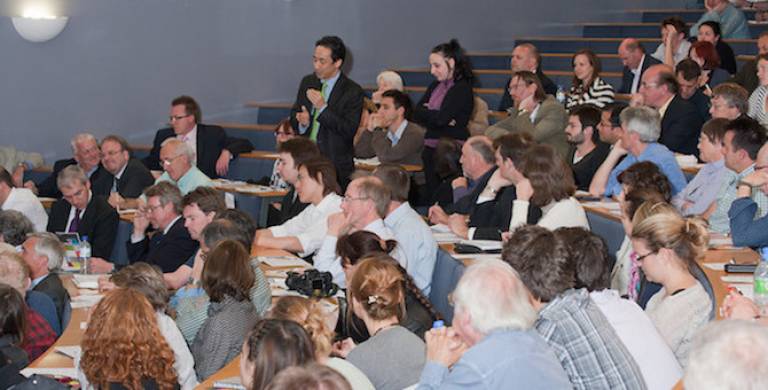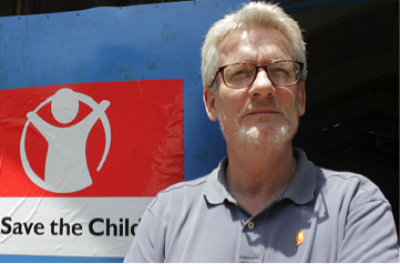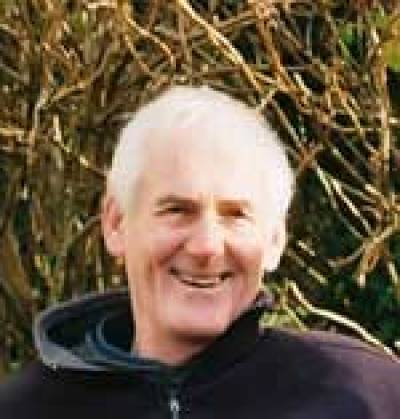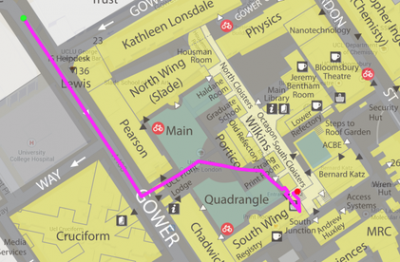Annual Conference Programme 2015
15 April 2015
UCL Gustave Tuck Lecture Theatre and South Cloisters, 09:00 - 20:00 A day of thought-provoking discussions, talks by experts and presentations of the latest research in risk and disaster reduction, aimed at researchers and practioners, NGOs and City professionals, and the interested public.

This year our Keynote Address, on Communicating Risk and Hazard to Policy Makers, will be given by Professor Sir Mark Walport, Government Chief Scientific Advisor.
Conference Themes
Current Views of Future Arctic Risks
Chair: Dr Ben Lishman, UCL IRDR
The near future of the Arctic is uncertain. There is a scientific consensus that we can expect a continued reduction in sea ice extent and volume, but the broader implications of this change are difficult to predict. Many risks are predicted in the Arctic - to indigenous people, to the biosphere, to commercial activities and to geopolitical relations, for example - but these risks are unlikely to play out immediately. How well can our current understanding describe the future of risk in the Arctic?
We will hold a panel discussion on Arctic Risks, discussing the risks associated with different activities in the arctic, such as oil exploration, tourism, and shipping trade routes. Addressing arctic risks, and their potential consequences, requires a breadth of expertise: technological, but also commercial, legal, sociological and governmental. Our panel discussion will discuss arctic risks, drawing on these different areas of expertise and the competing interests in the fragile arctic environment.
Panellists: Julian Hunt, Tim Stockings, Jill Barrett, Edward Heartney, Tim Reilly.
Visualisation and Presentation of Hazards and Risks
Chair: Dr Joanna Faure Walker, UCL IRDR
The aim of the "Visualisation of hazard and risk" session is to discuss displaying quantitative data to wide audiences. At the IRDR we encourage cross-disciplinary research alongside hard science and key questions arise regarding optimal ways of explaining risk and displaying scientific and statistical data to those without these backgrounds both for other researchers and members of the public and stakeholders. Key questions include how hazard and risk maps should be presented, why scientific information has been misunderstood, what tools are available for creating clear visualization of data and how can scientists better present their results for non-scientific audiences.
There will be a session of talks, addressing different ways that hazards and risks can be presented and visualised for different audiences and purposes. This will be of interest to those who produce the hazard and risk data, and to users of this data who seek better understanding and usability of this data.
Speakers: Tobias Sturt (Graphic), Richard Teeuw (University of Portsmouth), Richard Wall (UCL Hazard Centre), Vanessa Banks (BGS).
In Conversation on the Management of the Ebola Crisis
Chair: Dr Ilan Kelman, UCL IRDR and UCL IGH
Dr Michael von Bertele CB OBE FRCP, Humanitarian Director for Save the Children International, will be interviewed on the emergence of the Ebola crisis, how this global health crisis has been managed, and his involvement in the management of this crisis with Save the Children. He will be interviewed by Dr Smitha Mundasad, BBC science and health journalist , before answering further questions posed by the audience.
Save the Children were approached by DFID in late August 2014 to set up and manage an Ebola treatment centre in Sierra Leone. Against a background of high expectation and an escalating epidemic they started from zero to recruit and train the staff, build and equip a hospital, and put in place the policies to underpin the delivery of a safe facility. Drawing on personnel from UK, Cuba, and Sierra Leone, they opened on 7 November and by Chirstmas were running an 80 bed facility delivering very high levels of care.
Keynote: Communicating Risk and Hazard to Policy Makers
By Prof Sir Mark Walport, Government Chief Scientific Advisor
When scientists and other experts communicate risk, hazard, and their associated uncertainties with policy makers and the broader public, they face challenges in how well their terminology is understood and in the different viewpoints and values that policy makers may associate with risk and hazard. Having frequently faced and overcome these issues in his role as Government Chief Scientific Advisor, Sir Mark Walport will address them in his Keynote address, which he summarises as:
Being an effective communicator is essential to be a successful scientist. Clear and informative communication is especially important in an emergency when policy-makers need to make decisions quickly. Outside of an emergency, communication of hazard and risk can still be very difficult due to the uncertainties associated with hazard and risk assessments and potential confusion of language. As such, scientists need to consider the needs of their audience, and be precise in the language they use in order to communicate risk and hazard expertise to policy makers well.
Calculating, Portraying, Understanding and Reducing Risk
Session Chair: Dr Gordon Ross
1. Structural geology and recurrence intervals of active normal faults in the central and northern Italian Apennines.
Zoë K. Watson1, Gerald P. Roberts2, Joanna P. Faure Walker1, Peter Sammonds1,
1 UCL IRDR; 2 Department of Earth and Planetary Sciences, Birkbeck, University of London
2. The effect of ice rubble on ice-ice sliding
Sally Scourfield1, Peter Sammonds1, Ben Lishman1, Kaj Riska2
1 UCL IRDR; 2 TOTAL
3. Validation of ground motion simulations through spectral-shape and duration proxies for the nonlinear response of engineered systems
Alexandra Tsioulou and Carmine Galasso
Both at: Dept. of Civil Environmental & Geomatic Engineering and Institute for Risk and Disaster Reduction, UCL
4. Modeling fluid-induced seismicity
Georgios Michas1, Filippos Vallianatos1,2, Peter Sammonds1
1 UCL IRDR, 2 Laboratory of Geophysics and Seismology, Technological Educational Institute of Crete
5. Self-protective behaviour during earthquake shaking
Gillian Dacey
UCL IRDR
6. Is the deep groundwater in Bangladesh at risk of arsenic contamination?
Mohammad Shamsudduha1, Anwar Zahid2, William Burgess3
1 UCL IRDR, 2 Ground Water Hydrology, Bangladesh Water Development Board, Dhaka, Bangladesh, 3 Department of Earth Sciences, UCL
7. Permeability in volcanic systems at elevated temperatures and pressures: An Experimental Approach
Amy Chadderton1, Peter Sammonds1, Philip Meredith2, Rosanna Smith1, and Hugh Tuffen3
1 UCL IRDR, 2 Department of Earth Sciences, UCL, 3 Lancaster Environment Centre, Lancaster University
8. An interacting natural hazards approach to assessing disaster risk
Melanie Duncan1, Mirianna Budimir2 and Joel Gill3
1 British Geological Survey, 2 Independent Consultant, 3 King's College London
9. Accumulation of Risk in Urban India: Cities provide transformational opportunity for risk reduction
Garima Jain and Teja Malladi
Indian Institute for Human Settlements, Bangalore, India
10. Insufficient Historical Earthquakes for Probabilistic Seismic Hazard Assessment - Why Active Faults are needed
Luke N.J. Wedmore1, Gerald P. Roberts2, Joanna P. Faure Walker1, Ioannis Papanikolaou3, Ken McCaffrey4, Peter Sammonds1, Patience A. Cowie5, Laura C. Gregory6, Zoe K. Watson1, Alessandro Maria Michetti7
1 UCL IRDR, 2 Department of Earth and Planetary Sciences, Birkbeck College, University of London, 3 Laboratory Mineralogy - Geology, Agricultural University of Athens, Greece, 4 Department of Earth Sciences, Durham University, 5 University of Bergen, Department of Earth Science, Bergen, Norway, 6 School of Earth and Environment, University of Leeds, 7 Dipartimento di Scienza e Alta Tecnologia, Università degli Studi dell'Insubria, Como, Italy
11. The need for detailed fault measurements across active faults for seismic hazard
Joanna Faure Walker
UCL IRDR
12. Integrating Disaster Risk Reduction concept into chemistry curriculum in secondary high school in Indonesia. A case study in Banda Aceh, Indonesia.
Nurmalahayati Nurdin
UCL IRDR
13. Are earthquakes predictable? A study on magnitude correlations in California.
Katerina Stavrianaki
UCL IRDR
14. Engineering Applications of Earthquake Early Warning Systems
Omar Velazquez Ortiz and Carmine Galasso
Both at: Dept. of Civil Environmental & Geomatic Engineering and IRDR, UCL
15. Enabling Disaster Risk Reduction (DRR) Knowledge by Working Together (?): Insights from non-European Contexts
Funda Atun1, Scira Menoni1, Patrick Pigeon2, Fernando Briones3, María-José Jiménez4, Mariano García-Fernández4
1 Politecnico di Milano, Department of Architecture and Urban Studies (DAStU), Italy, 2 Université de Savoie-Mont-Blanc, Chambéry, France, 3 Center of Research and Higher Studies in Social Anthropology (CIESAS), Mexico DF, Mexico, 4 Institute of Geosciences (CSIC,UCM), Madrid, Spain
16. The impact of disasters on political trust and satisfaction with the government
Frederike Albrecht
Department of Government and Centre for Natural Disaster Science (CNDS), Uppsala University
17. Challenges in Collaborative Disaster Risk Reduction and Management
Jenni Koivisto1 and Helena Hermansson2
1 Centre for Climate and Safety / Centre for Natural Disaster Studies, Karlstad University, 2 Department of Government, Uppsala University, Swedish National Defence College / Centre for Natural Disaster Studies
18. Understanding and reducing Cascading Disasters: Addressing the vulnerability path
Gianluca Pescaroli
UCL IRDR
19. Collaborative risk management across the London health economy
Liz Clark and Chloe Sellwood
Both at: NHS England (London) and London Local Health Resilience Partnership
20. Fuzzy classification of the disaster risk within the socio-economic setting of the affected area
Sara Saremi
Brunel Business School
21. Frequency-Magnitude Distribution and Heat Flow in Greece
GiorgosPapadakis1, FilipposVallianatos1,2, Peter Sammonds1
1 UCL IRDR, 2 Technological Educational Institute of Crete, Laboratory of Geophysics and Seismology, Crete, Greece
22. The deformation characteristics and response relationship with the influencing factors of the typical colluvial landslide in the Three Gorges Reservoir
Ying CAO1,2, Kunlong YIN1
1 Department of Engineering Faculty, China University of Geosciences, Wuhan, China, 2 UCL IRDR
23. Fire Smart Territory: a wildfire risk management concept based on a social-ecological approach
Fantina Tedim1, Vittorio Leone2, Gavriil Xanthopoulos3
1 University of Porto, Geography Department, Porto, Portugal, 2 University of Basilicata, Department of Crop Systems, Potenza, Italy, 3 Hellenic Agricultural Organization "Demeter", Institute of Mediterranean Forest Ecosystems, Athens, Greece
24. Government-to-Citizens (G2C) communications in the post-disaster reconstruction phase: Emilia Romagna earthquakes case study
Serena Tagliacozzo
UCL IRDR
25. The importance of effective hazard communication and data sensitivity: hazard mapping of Campi Flegrei
Danielle Charlton, Christopher Kilburn, Stephen Edwards, Rosa Sobradelo
UCL Hazard Centre & UCL IRDR
26. Gendering risk communication - lessons for emergency managers
Kevin Blanchard
DRR Dynamics
27. Many Strong Voices: Dealing with change in the Arctic and on small island developing states (SIDS)
Ilan Kelman1, John Crump2, Tiina Kurvits2, Stavros Mavrogenis3
1 UCL IRDR and IGH, 2 GRID-Arendal, Norway, 3 Panteion University of Athens, Greece
Conference Downloads
The call for abstracts for the poster session on, "Calculating, Portraying, Understanding and Reducing Risk" has now closed.
Speaker Profiles:
Keynote: Prof Sir Mark Walport: Chief Scientific Advisor to HM Government

Sir Mark is the Chief Scientific Adviser to HM Government and Head of the Government Office for Science.
Previously, Sir Mark was Director of the Wellcome Trust, which is a global charitable foundation dedicated to achieving extraordinary improvements in human and animal health by supporting the brightest minds. Before joining the Trust he was Professor of Medicine and Head of the Division of Medicine at Imperial College London.
He is Co-Chair of the Prime Minister's Council for Science and Technology and has been a member of this since 2004. He has also been a member of the India UK CEO Forum, the UK India Round Table and the advisory board of Infrastructure UK and a non-executive member of the Office for Strategic Coordination of Health Research. He is a member of a number of international advisory bodies.
He has undertaken independent reviews for the UK Government on the use and sharing of personal information in the public and private sectors: 'Data Sharing Review' (2009); and secondary education: 'Science and Mathematics: Secondary Education for the 21st Century' (2010).
He received a knighthood in the 2009 New Year Honours List for services to medical research and was elected as Fellow of The Royal Society in 2011.
In Conversation: Dr Michael von Bertele CB OBE FRCP: Humanitarian Director, Save the Children

Michael will be the interviewee for our in Conversation session on the management of the Ebola Crisis.
Dr Michael von Bertele trained in medicine in Cardiff and joined the Army in 1976. He accredited as a consultant in Aviation and Occupational Medicine in 1992. He served in operational, command and staff appointments in the field and UK MoD, UN and NATO, retiring in 2012 as the Director General of the Army Medical Services. He became Humanitarian Director for Save the Children International in November 2013, and has overseen humanitarian responses in the Philippines, the Middle East, Africa, and notably, Sierra Leone, where he led on the establishment of the Save the Children Ebola treatment centre at Kerry Town.
In Conversation: Dr Smitha Mundasad, BBC Science and Health Journalist
Dr Mundasad will discuss the management of the Ebola crisis with Dr Michael von Bertele in the in Conversation session.
Dr Smitha Mundasad is a broadcast journalist at the BBC, covering health and science news. She has worked across BBC World Service radio, BBC World TV, and the BBC news website. In recent months, she has written several articles on the Ebola crisis and been interviewed on TV and radio about this crisis.
Prof Lord Julian Hunt: Emeritus Professor of Climate Modelling, UCL

Julian will be speaking in the Current Views of Future Arctic Risks session.
Julian Hunt, Baron Hunt of Chesterton, is a meteorologist and climatologist and was Director General of the British Meteorological Office from 1992 to 1997. He recently sat on the House of Lords Arctic Committee, which had a remit to evaluate recent and expected changes in the Arctic and their implications for the UK and its international relations, and which published its findings in February this year.
Tobias Sturt: Director, Graphic
Tobias will be speaking in the Visualisation and Presentation of Hazards and Risks session.
Tobias Sturt is a director of Graphic, an agency which specialises in information design and data visualisation. Together with his Content Director, Tobias runs the Guardian Masterclasses in Data Visualisation. Formerly Tobias was the Design Manager of the Guardian's Digital Agency.
Tobias has worked in online media for over a decade and in all kinds of roles, from conceptual and creative right down to nitty gritty development. His main area of expertise and interest is in visual and interactive communication and storytelling, while his skills include concept development, design management and data visualisation. Through his company, previous work and running the masterclasses, Tobias is used to catering for and teaching a wide variety of clients and audiences.
Abstract:
Data visualisation helps communicate complex and sophisticated stories by giving the audience an intuitive, immediate visual overview of a data set and helping them navigate and explore that data set, finding insights in it, both the insights we wish to share and the ones they find for themselves.
The act of visualising does this by structuring the data into graphics, which necessitates selecting data and choosing to emphasise parts of it. To do this successfully we have to consider the nature of the data and what it is that will make it useful to the audience. What do they want and what do we want for them?
Doing this means considering the language of the visual representation of data - what charting does to data and to the audience's comprehension of the data. But it also means understanding the visual techniques of communication, how the structuring and impact of visuals effect the structuring and impact of information.
By thinking about the data and the audience and what one needs from the other, and knowing how to create that relationship, we can make data visualisation that is both interesting and informative, attractive and clear.
Dr Richard Teeuw: Principal lecturer, Earth and Environmental Sciences, University of Portsmouth
Richard will speak in the session on Visualisation and Presentation of Hazards and Risks.
Dr Richard Teeuw is a principal lecturer at the School of Earth and Environmental Sciences, University of Portsmouth. Current research interests focus on free or low-cost approaches to using satellite imagery and GIS for assessing hazards, vulnerability and risk, as well as geoinformatic technology transfer and capacity building in developing countries for disaster management. He has extensive experience of using geomorphology and remote sensing to map geohazards and natural resources, consulting for BP Minerals International, Rio Tinto, Pioneer Goldfields, Golden Star Resources and NorWest Resources, as well as the Environment Agency and the overseas development agencies of Canada (CIDA), Germany (GTZ) and Japan (JICA). Ongoing research projects are in SE Spain and the Caribbean. Richard is also a member of the steering committee of the SPIDER network (Science and Policy Interactions for Disaster Risk Reduction).
Abstract:
A fundamental feature of Disaster Risk Reduction (DRR) is effective communication, whether for hazards, vulnerable features or high-risk areas; whether during the preparedness, response or recovery stages of a disaster.
Many types of risk have a significant spatial nature, particularly with regard to hazards and social-economic vulnerability. Consequently maps and GIS-based analysis are key players in data visualisation for DRR.
This study presents examples of 2-D, 3-D and 4-D mapping from Portsmouth University research projects in the DRR sector, along with visualisations from some non-spatial research that use colour and 3-D views to highlight key features.
Data visualisation trends and challenges in the DRR sector are considered, including crowd-source mapping and a study examining how risk perception can be visualised and analysed over space and time.
Dr Richard Wall: Research Associate, UCL Hazard Centre
Rick will speak in the session on Visualisation and Presentation of Hazards and Risks.
Dr Richard Wall holds a PhD at the UCL Hazards Centre at University College London. His early research focused on improving forecasts of volcanic eruptions on Mount Etna by combining seismic data measured in the field with analogous laboratory experiments. As a postdoctoral research associate in the NERC PURE program, his research aimed to enhance the visualisation of risk from natural hazards and to improve the communication of risk to affected populations, by combining commercial tools and data collected by non-governmental organisations. This work was initially applied to flood risk in Cambodia and then also to volcanic risk in Indonesia. He is currently at the University of Liverpool, using laboratory experiments to enhance our understanding of the processes leading to volcanic eruptions.
Abstract:
Identifying and visualising risk is critical for improving disaster risk reduction and communicating it to different end users. To this end we initially adapted and applied ImpactOnDemand®, a commercial software platform developed by Aon Benfield, to address the needs of the humanitarian and development sectors. We have also applied the same methodology in more commonly used Geographical Information System (GIS) software to enable different stakeholders to create their own visualisations. The method identifies individual population centres that are exposed to a range of hazard footprints. The hazard element can be represented by hazard maps of past events or satellite images taken during an event. Populations are drawn from census data, but these are often of variable quality and resolution and may compromise the accuracy of the estimation of risk. This methodology has been applied to communities at risk from flooding in Cambodia and volcanic eruptions in Indonesia.
To aid decision makers in response to disaster scenarios, or for long-term planning, visualisations have been combined with a social vulnerability index, within which census data have been compared with community-based participatory vulnerability and capacity assessments. This provides a method of identifying and prioritising vulnerable communities using criteria they themselves have selected.
The creation of these visualisations for communities at risk from natural hazards shows that census and hazard datasets can be used to communicate risk quickly and effectively and at low cost. The methodology allows information on risk to be presented in bespoke formats to different stakeholders and highlights the mutual benefit of collaboration between academic research, the commercial sector and humanitarian and development organisations. Providing a methodology that can be used within a range of software is also key in enabling stakeholders to create their own visualisations and tailoring them for the requirements of specific organisations.
Captain Tim Stockings: Operations Director, British Antarctic Survey
Tim will be speaking in the Current Views of Future Arctic Risks session.
Tim Stockings read Engineering at Imperial College, London before joining the Royal Navy to fly helicopters. He served in a wide variety of ships on operations around the globe, including HM Royal Yacht Britannia. Since leaving the Navy, Tim has worked in the NHS running 999 operations for an ambulance service and until recently was the Risk Director for Saga shipping. In 2014 Tim became the Operations Director for the British Antarctic Survey (BAS), based in Cambridge.
Jill Barrett: Senior Research Fellow, British Institute of International and Comparative Law
Jill Barrett is the Arthur Watts Senior Research Fellow in Public International Law at the British Institute of International and Comparative Law. She leads the Institute's programme of international law research and events. Her research interests include treaty law and practice, law of the polar regions, international environmental law and law of the sea.
She is also an independent consultant in international law, providing advice, research and training seminars to various governments, international organisations and NGOs.
Jill was Legal Counsellor at the Foreign & Commonwealth Office until 2010. She was UK Deputy Agent in the Mox Plant Cases under UNCLOS and OSPAR, and represented the UK at international conferences such as the Antarctic Treaty Consultative Meeting, Commission on the Conservation of Antarctic Living Marine Resources, London Convention (on marine pollution), International Whaling Commission and UN Commission on Environment and Development, and served as First Secretary (Legal) at the UK Mission to the UN, New York. Before joining the FCO in 1989 she was Lecturer in the Law of the People's Republic of China at SOAS, London University, and Lecturer in Law at Durham University.
Dr Vanessa Banks: Team Leader, BGS
After gaining a PhD in karst hydrogeology Vanessa was employed as a BGS research scientist working across a broad range of disciplines, but with a strong focus on applied geology. Vanessa was appointed Team Leader for Shallow Geohazards and Risks in 2012. In this role she leads on the strategic direction of research in landslides, clay shrink-swell and karst geohazards. Her current research interests are focused on the development of ground models and include: the application of the concepts of hydrogeological domains and urban hydrology to 3D modelling to support aquifer recharge and vulnerability studies; the development of karst domains (zoning areas of similar stratigraphical and structural influences on hydrogeology) and the implications for conceptual models, i.e. determining formation-specific aspects of the physical hydrological (recharge, flow and discharge) and geochemical properties of groundwater through detailed geological and hydrogeological investigation; geological and hydrogeological investigation of formational, structural and human influences on hydrogeology in the context of conceptual model development to aid in the assessment of the environmental impacts of abandoned mine workings; ground models for landfill environments, and landslide hazard susceptibility assessments for infrastructure. Vanessa's research career followed approximately 15 years in industry working as an engineering geologist/ geotechnical engineer in both consulting and contracting roles. Her early career focused on low level restoration schemes for the mineral extractive industry and the hydrogeological aspects of waste disposal. Following award of an MSc/DIC in Engineering Geology (dissertation on the stability of underground chalk workings) she joined a consultancy specialising in using new technologies (e.g. light weight geotextile fills and geotextile reinforcement) for ground engineering solutions, then specialised in site investigation working as a resident engineer for Canada Water Station (Jubilee Line extension) and Client's representative for the Isle of Dogs Northern Drainage Tunnel. Subsequent project specialisation focused on flood risk assessments, contaminated land and Pollution Prevention Control applications for agricultural installations and waste disposal facilities.
Edward Heartney: US Embassy
Ed Heartney serves as the Counselor for Environment, Science, Technology and Health in the U.S Embassy in London. Ed has focused on climate change and clean energy, the Arctic, Oceans, Space, Science cooperation, and Ebola. The United States is very pleased to have assumed the chair of the Arctic Council, and the United States will press forward with the agreed priorities during our two year chairmanship of the Arctic Council.
Tim Reilly: Arctic Advisory Group
Tim Reilly is the Co-Founder of Arctic Advisory Group, (www.arcticadvisorygroup.eu) a UK/Norwegian Arctic Risk Management and Research consultancy working in the Energy, Mining, associated Infrastructure, and Shipping sectors.
Tim was Shell's Government Affairs Adviser in the Caspian region in the nineties, as well as working in the Caucasus, Central Asia, Russia and Ukraine, for companies such as Chevron and JKX Oil & Gas. His first experience of the Arctic was as a young paratroop officer where he spent three winters inside the Arctic Circle, training in Arctic warfare.
Annual Conference Programme 2015
| 09:00 - 09:20 | Registration |
| 09:20 - 09:30 | Welcome from Peter Sammonds, Director, UCL IRDR |
| 09:30 - 11:00 | Panel Discussion on "Current Views of Future Arctic Risks" Chair: Dr Ben Lishman |
| 11:00 - 11:30 | Coffee Break |
| 11:30 - 12:00 | Hazard and Risk Visualisation (part 1). Chair: Dr Joanna Faure Walker |
| 12:00 - 13:00 | Keynote address on, "Communicating Risk and Hazard to Policy Makers", by Professor Sir Mark Walport, Government Chief Scientific Advisor |
| 13:00 - 14:30 | Lunch (not provided) |
| 14:30 - 15:30 | Hazard and Risk Visualisation (part 2) |
| 15:30 - 16:00 | Coffee Break |
| 16:00 - 17:00 | In conversation on the Ebola Crisis with Dr Michael von Bertele. Chair: Dr Ilan Kelman |
| 17:00 - 17:30 | Poster Introductions. Chair: Dr Gordon Ross |
| 17:30 - 20:00 | Poster session and Reception |
This conference is free to attend, but you need to register

On the day before the annual conference, Weds 24th June, UCL IRDR will hold its Third Academic Summit. Whilst the annual conference is a showcase of the latest research, issues, and developments in disaster risk reduction, the academic summit is a discussion meeting where academics and practitioners will debate the most important issues they face as they collaborate in order to make disaster risk reduction and resilience a thriving discipline that serves the needs of users and society. Find out more...
 Close
Close







